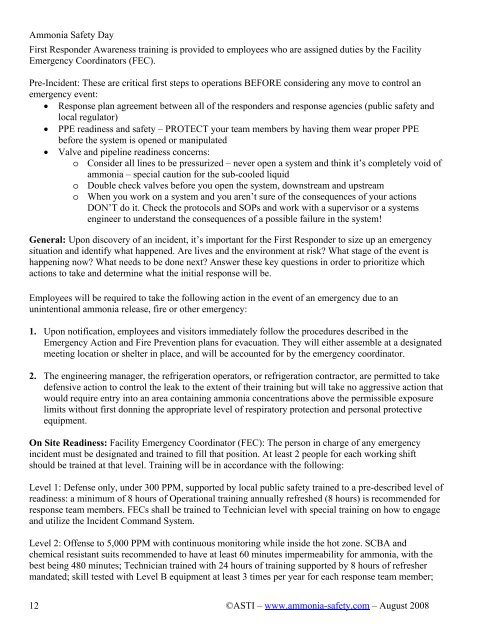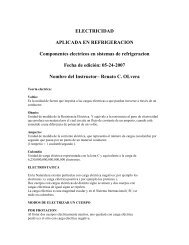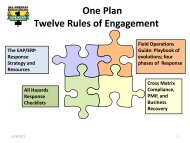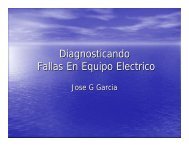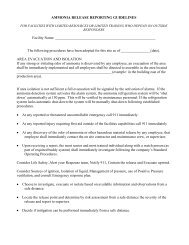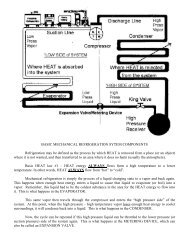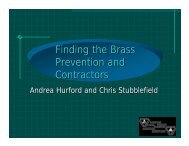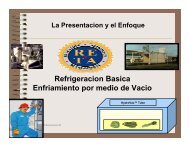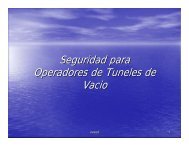Awareness Training Goals - Salinas Valley Ammonia Safety Day
Awareness Training Goals - Salinas Valley Ammonia Safety Day
Awareness Training Goals - Salinas Valley Ammonia Safety Day
Create successful ePaper yourself
Turn your PDF publications into a flip-book with our unique Google optimized e-Paper software.
<strong>Ammonia</strong> <strong>Safety</strong> <strong>Day</strong><br />
First Responder <strong>Awareness</strong> training is provided to employees who are assigned duties by the Facility<br />
Emergency Coordinators (FEC).<br />
Pre-Incident: These are critical first steps to operations BEFORE considering any move to control an<br />
emergency event:<br />
• Response plan agreement between all of the responders and response agencies (public safety and<br />
local regulator)<br />
• PPE readiness and safety – PROTECT your team members by having them wear proper PPE<br />
before the system is opened or manipulated<br />
• Valve and pipeline readiness concerns:<br />
o Consider all lines to be pressurized – never open a system and think it’s completely void of<br />
ammonia – special caution for the sub-cooled liquid<br />
o Double check valves before you open the system, downstream and upstream<br />
o When you work on a system and you aren’t sure of the consequences of your actions<br />
DON’T do it. Check the protocols and SOPs and work with a supervisor or a systems<br />
engineer to understand the consequences of a possible failure in the system!<br />
General: Upon discovery of an incident, it’s important for the First Responder to size up an emergency<br />
situation and identify what happened. Are lives and the environment at risk? What stage of the event is<br />
happening now? What needs to be done next? Answer these key questions in order to prioritize which<br />
actions to take and determine what the initial response will be.<br />
Employees will be required to take the following action in the event of an emergency due to an<br />
unintentional ammonia release, fire or other emergency:<br />
1. Upon notification, employees and visitors immediately follow the procedures described in the<br />
Emergency Action and Fire Prevention plans for evacuation. They will either assemble at a designated<br />
meeting location or shelter in place, and will be accounted for by the emergency coordinator.<br />
2. The engineering manager, the refrigeration operators, or refrigeration contractor, are permitted to take<br />
defensive action to control the leak to the extent of their training but will take no aggressive action that<br />
would require entry into an area containing ammonia concentrations above the permissible exposure<br />
limits without first donning the appropriate level of respiratory protection and personal protective<br />
equipment.<br />
On Site Readiness: Facility Emergency Coordinator (FEC): The person in charge of any emergency<br />
incident must be designated and trained to fill that position. At least 2 people for each working shift<br />
should be trained at that level. <strong>Training</strong> will be in accordance with the following:<br />
Level 1: Defense only, under 300 PPM, supported by local public safety trained to a pre-described level of<br />
readiness: a minimum of 8 hours of Operational training annually refreshed (8 hours) is recommended for<br />
response team members. FECs shall be trained to Technician level with special training on how to engage<br />
and utilize the Incident Command System.<br />
Level 2: Offense to 5,000 PPM with continuous monitoring while inside the hot zone. SCBA and<br />
chemical resistant suits recommended to have at least 60 minutes impermeability for ammonia, with the<br />
best being 480 minutes; Technician trained with 24 hours of training supported by 8 hours of refresher<br />
mandated; skill tested with Level B equipment at least 3 times per year for each response team member;<br />
12<br />
©ASTI – www.ammonia-safety.com – August 2008


